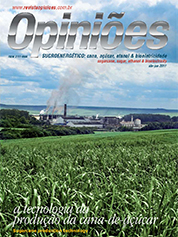Paulo Lordelo Novaes
President of GAtec
Op-AA-28
Planning management and transportation logistics
With the coming about of globalization of the economy, one notices that some economic, social and environmental events are changing the business environment in the sugarcane-based industry, mainly as related to major mergers and acquisitions. Companies perceive the reflex of such transformations and in our view this new scenario requires using new strategies and instruments.
In Production Planning and Control one currently has software with excellent flexibility features – which consider particular characteristics of each company, as well as integration features, allowing for the exchange of information between existing agricultural, industrial and administrative systems, along with a series of other benefits.
With the intent of meeting such requirements, companies engaged in information technology have been making available a series of informatics solutions that encompass activities from the crop planting phase to accounting entries of agricultural and industrial production activities and calculating costs involved in the process, in addition to integrating management software (Enterprise Resource Planning software).
Based on experience obtained in working with more than 130 partner and allied companies, we have detailed some of the solutions for supporting planning and agricultural logistics solutions for sugarcane-based energy operation units. Optimized harvest planning: An optimized harvest planning software must use linear programming techniques, while aiming principally at delivering a monthly harvest plan for all lots belonging to a given mill.
Studies show that mills using this kind of system, and an optimized plan, achieved a 4 to 7% increase in average harvest pol%cane, which directly reflected in the maximization of the profit contribution margin in the agro industrial complex and of the companies’ profitability.
The software’s base information is extracted from an agricultural database classified by lot (area, production estimate, distance, cutting phase, planting dates, the last cut, etc.) and considers a series of operational, agronomic and industrial restraints, such as the maximum and minimum crushing and juice processing capacity, the existence of cutting fronts and the fleet available for transportation, the average distance to each harvest front, the energy balance (% of minimum fiber per harvest period), etc.
In processing such information, the software is expected to define the best harvest date of all varieties based on the Minimum Loss concept, checking the pol%cane rate of all varieties, in all harvest months, while exploring the potential of each variety in each harvest month.
Apart from such functionality, the harvest planning software must allow for analyses such as verifying the feasibility of using maturators on certain lots, the ideal monthly quantity of applied vinasse, determining maximum average distances per harvest front, and showing the best logistics sequencing for the month’s harvest.
Transportation Logistics: After doing the entire agricultural planning and adopting the harvest’s best operational control systems, there is nothing more frustrating than being faced with the lack of raw material in the crusher, due to errors in transporting sugarcane. There are often reports of cases involving excessive trucks at any given cutting and loading front, while others are idle.
To increase the available fleet may not always be the solution, apart from causing an increase in transportation costs – if the fleet is your own – or resulting in discontent and rendering the service performed by freight forwarders unfeasible, because they will be penalized by too many lines of trucks in the field and at the weighing equipment or unloading yard.
A tool that greatly facilitates running such operations is transportation logistics software, which intelligently distributes the truck fleet to cutting fronts, so as to maintain a constant flow of raw material to the mill, avoiding the formation of unwanted lines and idleness at the loading fronts by properly dimensioning the fleet.
Using such tools can result in cutting, loading and transporting cost savings of up to 5%, in addition to benefits such as managing truck driver shift changes, supply control and autonomy, and dimensioning harvest fronts.
Conclusion: The available technology developed rapidly and consumers have become increasingly more demanding, because they know that a right decision, made in the right timeframe, has become a matter of survival for companies. Today’s manager knows success does not happen by chance. Personal abilities of managers in charge are essential, but will significantly be reduced if they lack effective and modern management tools.
Along this line, adopting planning and logistics software has become essential, in light of the huge volume of information processed in such operations, which is almost impossible to manage without using specialty software. However, like in every investment, buying software must be done carefully, assessing costs and benefits of each option available in the market, making sure it actually complies with its stated capacities.




